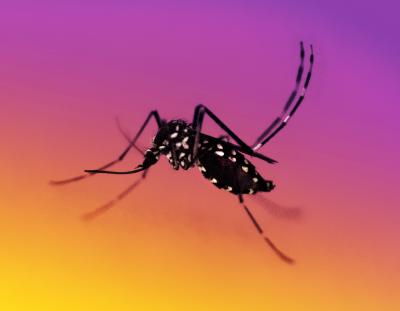Mosquitoes are considered one of the most dangerous animals on earth because of their broad distribution and the many pathogens they transmit to humans. Some of the most important human diseases in tropical and temperate regions of the planet are caused by mosquito-borne pathogens. Malaria, dengue, and filariasis, among other mosquito-borne diseases, kill or sicken millions of people worldwide every year.
Mosquito-borne pathogens are transmitted to the vertebrate host, such as a human, when the mosquito bites the host in search of blood. The proteins found in blood are essential for female mosquitoes: without it, they lack the resources to create eggs. Greater knowledge of the biological processes involved in the mosquito life cycle could lead to new or improved strategies to control mosquito populations.
Dr. Patricia Scaraffia, Associate Professor at the Tulane University School of Public Health and Tropical Medicine, has dedicated her career to understanding the metabolism of the mosquito Aedes aegypti that carries the pathogens responsible for dengue, Zika, chikungunya, and yellow fever to humans. NIAID reached out to Dr. Scaraffia about her team’s research.
What got you interested in studying mosquito metabolism?
I have studied the metabolism of insects that are vectors of pathogens causing human diseases since I was a graduate student at the Universidad Nacional de Cordoba, in Argentina. My Ph.D. dissertation was focused on the energy metabolism in Triatomine insects, vectors of Trypanosoma cruzi, the etiological agent of Chagas´ disease. After my dissertation, I participated as a speaker in a two-week course for PhD students entitled Biochemistry and molecular biology of insects of importance for public health. During the course, Argentinian professors encouraged me to contact the late Dr. Michael A. Wells, a leader in insect metabolism, and apply for a postdoctoral training in his lab. Soon after, I joined Dr. Wells´s lab at the University of Arizona as a research associate and opened a new line of investigation in his lab. Since then, I have never stopped working on A. aegypti mosquito metabolism. I am passionate and curious about the tremendous complexity of mosquito metabolism. It is a fascinating puzzle to work on. It constantly challenges me and my research team to think outside the box when trying to decipher the unknowns related to mosquito metabolism.

Dr. Patricia Scaraffia's work focuses on the secrets of mosquito metabolism.
What are the metabolic challenges faced by mosquitoes after feeding on blood?
Female mosquitoes are a very captivating biological system. It is during blood feeding that female mosquitoes can transmit dangerous, and sometimes lethal, pathogens to humans. Interestingly, the blood that the females take could be twice their body weight, which is impressive. Female mosquitoes have evolved efficient mechanisms to digest blood meals, eliminate excess water, absorb and transport nutrients, synthesize new molecules, metabolize excess nitrogen, remove nitrogen waste, and successfully lay eggs within 72 hours! Despite significant progress in understanding how females overcome these metabolic challenges, we have not yet fully elucidated the intricate metabolic pathways, networks, and signaling cascades, nor the molecular and biochemical bases underlying the multiple regulatory mechanisms that may exist in blood-fed female mosquitoes.
What are the greatest potential benefits of understanding mosquito metabolism?
Metabolism is a complicated process that involves the entire set of chemical transformations present in an organism. A metabolic challenge faced by mosquitoes is how to break down ammonia that results from digesting a blood meal and is toxic to the mosquito. With NIAID support, we found that in the absence of a functional metabolic cycle to detoxify ammonia, A. aegypti mosquitoes use specific metabolic pathways that were believed to be non-existent in insects. This discovery has opened a new field of study.
A better understanding of mosquito metabolism and its mechanisms of regulation in A. aegypti and other mosquito species could lead us to the discovery of common and novel metabolic targets and/or metabolic regulators. It would also provide a strong foundation for the development and implementation of more effective biological, chemical and/or genetic strategies to control mosquito populations around the world.
What are the biggest challenges to studying mosquito metabolism?
We have often observed that genetic silencing or knockdown—a technique to prevent or reduce gene expression—of one or more genes encoding specific proteins involved in mosquito nitrogen metabolism results in a variety of unpredictable phenotypes based on our knowledge of vertebrate nitrogen metabolism. Notably, female mosquitoes get control of the deficiency of certain key proteins by downregulating or upregulating one or multiple metabolic pathways simultaneously and at a very high speed. This highlights the tremendous adaptive capacity of blood-fed mosquitoes to avoid deleterious effects and survive.
We have been collaborating closely with scientists that work at the University of Texas MD Anderson Cancer Center Metabolomics Core Facility, and more recently, with bioanalytical chemists that work in the Microbiome Center’s Metabolomics and Proteomics Mass Spectrometry Laboratory in Texas Children’s Hospital in Houston. Our projects are not turn-key type of projects with quick turn-round times. We have to invest considerable time and effort to successfully develop and/or optimize methods before analyzing mosquito samples. Despite these challenges, our research work keeps motivating us to unlock the metabolic mysteries that female mosquitoes hold.
Your research has focused on Aedes aegypti, the main vector of dengue, Zika, etc. Why did you choose to study this mosquito species rather than others that are also important vectors of malaria and other diseases?
My research has focused on Aedes aegypti not only because it is a vector of pathogens that pose public health threats, but also because it is genetically one of the best-characterized insect species. The availability of the Aedes aegypti genome is a great resource for a wide range of investigations. In addition, Aedes aegypti is relatively simple to rear and maintain in the lab. In my lab, we are interested in expanding our metabolic studies to other mosquito species by working in collaboration with scientists with expertise in the biology of different vectors.
What important questions remain unanswered about mosquito metabolism?
Many important questions remain unanswered about mosquito metabolism. I’d like to highlight a few of them that may help us enhance our knowledge of the mosquito as a whole organism rather than as a linear sum of its parts. For example, what are the genetic and biochemical mechanisms that drive metabolic fluxes in mosquitoes in response to internal or external alterations? How do key proteins interact with each other, and how are they post-translationally regulated to maintain mosquito metabolism? How are the metabolic networks regulated in noninfected and pathogen-infected mosquitoes? What are the critical regulatory points within the mosquito metabolism and the vector-host-pathogen interface?
While basic science will continue to be crucial in answering these questions, to successfully fight against mosquitoes, we must work together as part of a multidisciplinary team of scientists to tightly coordinate our efforts and close the gap between basic and applied science.




